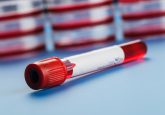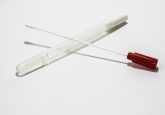Economical biosensor may diagnose cystic fibrosis

Researchers from Pennsylvania State University (State College, PA, USA) have developed a novel, low-cost fluorescent biosensor that has the capacity to detect electrolyte concentrations in sweat or other bodily fluids, which is particularly sensitive and selective for chloride, a key diagnostic biomarker for cystic fibrosis.
“Salt concentrations can be important for many health-related conditions,” commented study author, Jian Yang. “Our method uses fluorescent molecules based on citrate, a natural molecule that is essential for bone health.”
The study, recently published in Chemical Science, tested the clinical utility of citrate-based sensors as a novel method for diagnosis of cystic fibrosis by performing analytical validation with sweat controls and clinical validation with sweat from individuals with or without cystic fibrosis.
The results of the study displayed that the citrate sensor provided similar results when compared against the current gold standard sweat test performed in a clinical laboratory.
Abnormal levels of chloride in biological fluids can act as a potential indicator for a variety of diseases such as cystic fibrosis. However current analytical methods for detecting chloride in bodily fluids are unable to meet the clinical requirements of high performance and low-cost.
Therefore, researchers from Pennsylvania State University have developed a handheld device capable of measuring salt concentrations in sweat utilizing citrate-based molecules and a cell phone, which may become significantly useful as an analytical device in the developing world.
The novel fluorescent chloride sensor utilizes a single fluorophore to simultaneously detect multiple halides.
When compared to current methods, this device has demonstrated a higher sensitivity to chloride and the ability to identify over a wider range of concentrations. Additionally, the device is able to distinguish between chloride and bromine, a common weakness of traditional clinical laboratory tests.
“We are developing a platform material for sensing that is low cost, can be automated, requires no titration by trained staff or expensive instrumentation as in hospitals, and provides fast, almost instantaneous, results,” commented Zhiwen Liu, one of the researchers in the study.
The findings of this study suggest that citrate-based fluorescent devices may provide clinicians with an inexpensive, automated multi-analysis platform, which yields accurate results that can be readily translated into clinical settings.
Furthermore, the device has also demonstrated the potential to be utilized in the identification of other diseases that display abnormal concentrations of chloride in biological fluids such as metabolic alkalosis, Addison’s disease, and amyotrophic lateral sclerosis.
Lead author Jimin Kim concluded: “Our citrate-based platform for designing fluorescent sensors provides us with great versatility in tailoring sensors to specific applications. We hope to produce more sensors with interesting applications in the near future”
SOURCE: Kim JP, Xie Z, Creer M, Liu Z, Yang J. Citrate-based fluorescent materials for low-cost chloride sensing in the diagnosis of cystic fibrosis. Chem. Sci, doi: 10.1039/C6SC02962K (2016) (Epub ahead of print);
http://news.psu.edu/story/426864/2016/09/20/research/low-cost-sensor-cystic-fibrosis-diagnosis-based-citrate






